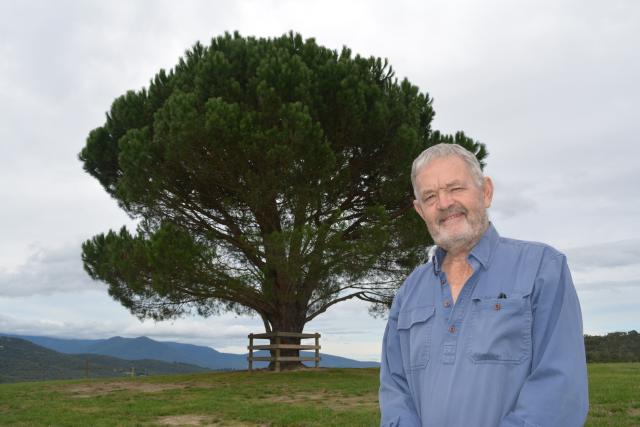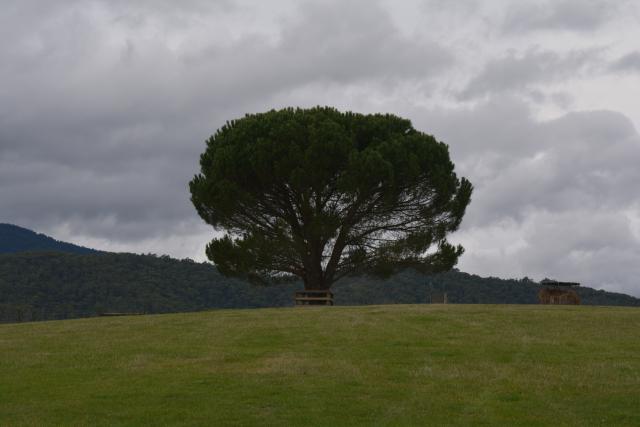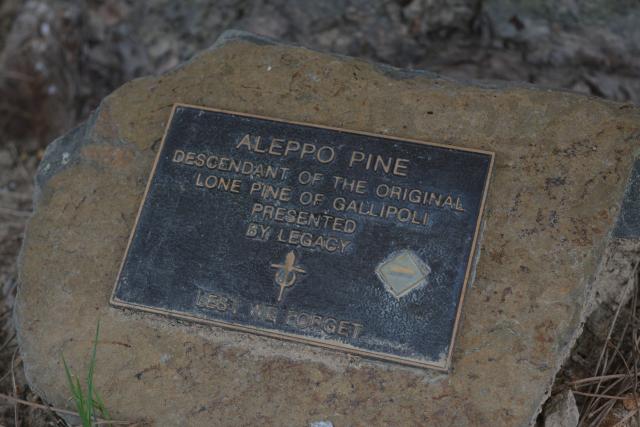
By Renee Wood
On the top of a hill in Chum Creek sits a large mature Aleppo Pine tree, planted on resident Ken Lang’s land by his late father, a Second World War veteran.
The pine has great significance for many reasons, one being of healing for Mr Lang’s father, Louis Ernest Kenneth Lang (nicknamed Ken, Jed, Lou) who was in the 2/14th Australian Infantry Battalion.
Lance Sergeant Lang served from 1939 to 1945 in Syria, North Africa, Papua New Guinea and Borneo.
“There’s a lot of things that he experienced during the war and it left quite a scar on his mind and memory and he just was passionate about everything concerning his battalion in the war,” Mr Lang said.
Serving on the Kokoda campaign was something the veteran was lucky to survive.
Mr Lang said his father was cut off with nine other soldiers who were lost for 39 days behind enemy lines and he was one of just two who were found.
“What happened during that 39 days to survive was pretty horrific,” he said.
The father and son only discussed this when visiting Kokoda together for ‘The Last Parade’ in 1997 with a group of other veterans.
“He opened up one night and told me some of his experiences.. so it was a pretty emotional trip with him up there.
”Although the Gallipoli pine tree is associated with the First World War, Mr Lang said his father wanted to plant it as a permanent reminder in a place he loved so much.
“When I bought this property he became quite attached to here as well and my mother passed away 10 years before him so he had spent a lot of time up here with us,” he said.
“I think he just wanted to have something that was permanent that related to the military background or legacy background that could be preserved.”
The tree was planted in 1993 by the then seventy-three year old veteran, who gained access to a seedling through Legacy that’s believed to be propagated off the commemorative Gallipoli Lone Pine tree in Canberra.
A plaque reading ‘Aleppo Pine descendant of the original lone pine of Gallipoli presented by legacy, lest we forget’ with the battalion’s emblem on it.
It has proven to be a strong survivor, thankfully holding together and recovering after the 2009 Black Saturday Bushfires, with everything else lost on the property.
“We recon it was the wind stress factor and the fact that my father’s ashes are up there that kept it going.”
Some of his ashes have also been planted on the Kokoda Track when Mr Lang visited after he passed in 2003.
“We worked out through talking with some other vets and locals where the headquartered company was when they were overrun by the Japanese. So we picked a tree out there and planted his ashes up there which I took with me.”
Now the Chum Creek resident is grateful the tree remains, standing as a reminder of his father and the sacrifices made by hundreds of thousands of young men during foreign conflicts.
The Lone Pine is used for commemorative purposes and links back to the 1st Australian Infantry Division’s major offensive at Plateau 400 on Gallipoli which began on 6 August 1915.
The ridge was once covered with the Aleppo pine but they were cleared to provide trenches, leaving just one, solitary pine as the area became known as Lone Pine Ridge.
The Australian War Memorial said after three days of brutal fighting the Anzacs succeeded in capturing the Turkish trenches, losing 2000 Australian men in the action.
“After the battle, Lance Corporal Benjamin Charles Smith, 3rd Battalion AIF, collected several pine cones from the branches used to cover the Turkish trenches. He sent the cones home to his mother, Jane McMullin, in remembrance of his brother Mark, who had died in the fighting on 6 August,” AWM reads.
“From one of these cones Mrs McMullin sowed several seeds, and successfully raised two seedlings. One was planted in Inverell, where both her sons had enlisted. The other was presented to the Australian War Memorial, to be planted in the grounds in honour of all the sons who fell at Lone Pine.”








